ROLEX ZUBMARINER
Zub, zorro, flat S...
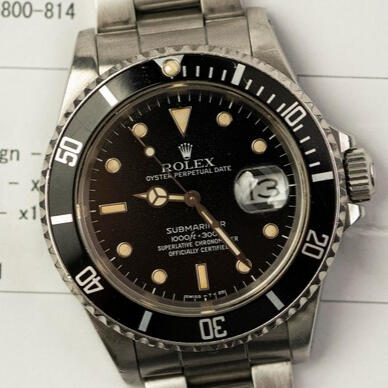
Rolex Submariner with Zubmariner, Zorro or Flat-S Dial — A Subtle Icon.
The Rolex Zubmariner
The Zubmariner is a rare and sought-after variant of the Rolex Submariner 16610, recognizable by a unique dial where the letter “S” in “Submariner” appears flattened — almost like a reversed Z. This site offers a detailed overview, visual comparisons, and tips on how to identify one with confidence.Nicknamed the “Zubmariner dial” — or sometimes the “Zorro dial” by collectors — this rare variation of the Submariner (notably reference 16610) stands out for a striking typographic anomaly.The “S” in “Submariner” lacks its usual curves and appears almost squared-off, giving it the look of a reversed Z — hence the nickname.While not officially recognized by Rolex, the term has been adopted by the collector community to describe this fascinating dial, which is increasingly sought after by seasoned vintage Rolex enthusiasts.
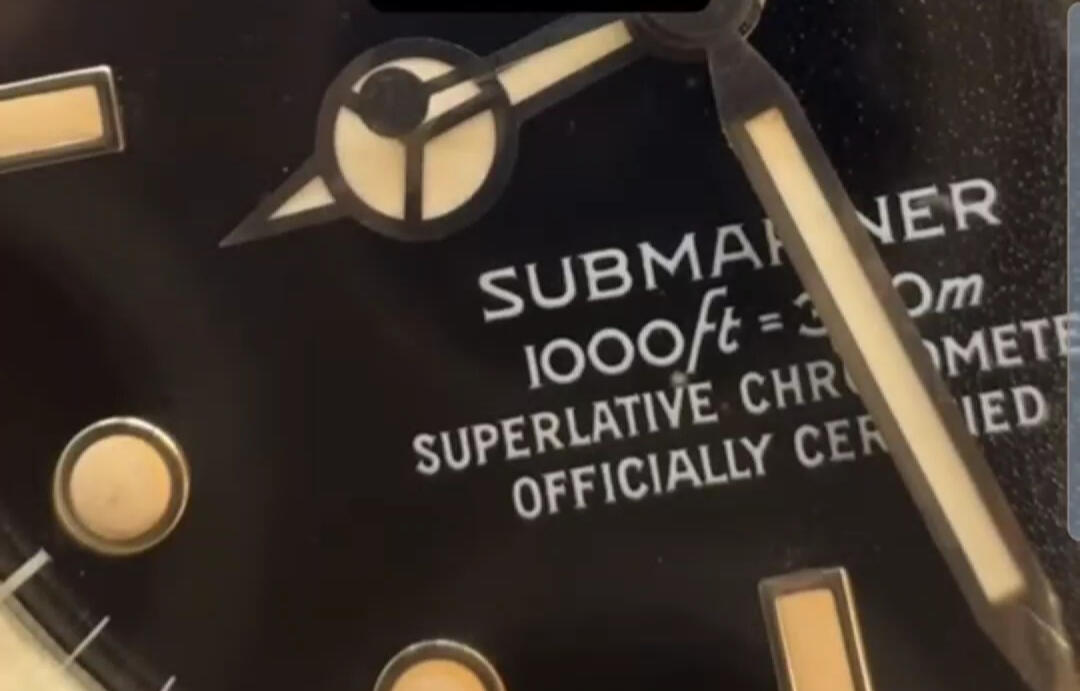
Tracing the Origins of a Forgotten Dial
The “Zubmariner” dial appears to be the result of an accidental manufacturing variation rather than an intentional or limited edition release.
Rolex has never officially acknowledged this dial, which strongly suggests it’s a production anomaly — undocumented and unintentional.
Most accounts trace its appearance back to the late 1980s, during a transitional period in Submariner production:🔹 On the transitional reference 168000 (1987–1988):
Several examples have been spotted featuring the now-iconic flat “S.”
One collector estimates that “the ‘Z’ appears on roughly 1 in 10 examples of the 168000” he has inspected.
Given the extremely short production window of the 168000 (just 7 to 9 months in 1987/88), this alone makes the Zubmariner variant exceptionally rare.🔹 On early Submariner 16610 models (1988–1990):
The flat “S” dial also appears on some of the very first 16610 Submariner Date models equipped with the new caliber 3135.
French collectors and dealers have noted that “the Zubmariner-style dial only appears on models from 1988 to 1990,” the earliest years of 16610 production.
One confirmed L-series Submariner from 1988 in France features the Zorro dial, further supporting the theory that Zubmariner dials were limited to watches produced between ~1988 and 1990.
After 1990, Rolex appears to have corrected the dial printing, returning to the standard curved “S.”🔹 A late reappearance in the early 2000s:
Interestingly, a more subtle version of the flat “S” resurfaced around 2002–2004. Certain Submariner No Date 14060M models from that period show a “semi-Zorro” dial — a less dramatic, partially flattened “S.”
It’s estimated that about 5% of 14060M Submariners from 2002–2006 feature this trait. Likewise, a handful of Submariner Date 16610 models from the K and Y serials (circa 2002–2004) with SEL end links have surfaced showing similar printing quirks.Still, this late occurrence is far subtler — and much less known — than the original Zubmariner dials from the late ’80s.
Identifying Features of the Zubmariner Dial
The Zubmariner’s defining trait is the shape of the “S” in “Submariner”: on a genuine example, both the top and bottom of the S are unusually flat, giving it the appearance of a stylized, reversed Z.To the naked eye, this can go unnoticed — but under magnification or when compared side-by-side with a standard dial, the difference becomes obvious.
English-speaking collectors often refer to it as the “Flat S”, while the nickname “Zorro dial” nods to the masked character who famously carved a “Z” — a playful reference to this hidden anomaly on the dial.Outside of this zebra-like S, the rest of the dial matches period-correct specs, though several other subtle typographic cues tend to accompany it. According to experts, Zubmariner dials from the late ’80s typically show:🔹 Rounded zeros in the depth rating (“1000 ft = 300 m”) — unlike the more oval zeros seen on other variants.🔹 The “ft,” “m,” and equals sign (“=”) printed in italics.These tiny details matter to dial purists, who categorize Sub dials into so-called “Marks.”For example, one British dealer notes that there are at least six known 16610 dial types (Mk1 to Mk6), and that “Mk II is immediately recognizable by the flat ‘S’ that resembles a reversed Z.” This “Mk II” corresponds precisely to the tritium Zubmariner dials from the late 1980s.Visually, Zubmariner dials are typically glossy black with white gold surrounds framing the tritium hour markers — standard fare for late-’80s Submariners. However, time hasn’t always been kind. Rolex had not yet fully mastered its glossy lacquer process in the late ’80s, and many of these dials have aged in unexpected ways:Some have turned matte over time. Others show fine spidering or cracking (“spider dials”) due to lacquer instability. A few even display color shifts, with the original deep black fading into tropical browns or, more rarely, purples — a form of chemical aging that’s highly prized among vintage collectors.One seller even listed a “Rolex Zubmariner Purple Dial” from 1989, combining the rarity of the flat-S print with a unique violet patina (source: fpluxurywatches.com).In short, the Zubmariner dial is primarily defined by its atypical “Submariner” print, where the flattened S subtly mimics a Z. It’s a small, easily overlooked detail — but unmistakable under the loupe — and often comes paired with other period-specific typographic quirks. Invisible to the untrained eye, these distinctions are exactly what drive vintage collectors to obsess over dial variants.
A Rolex Zubmariner 16610 from 1989 (left) compared to a classic 16610 from 1990 (right):
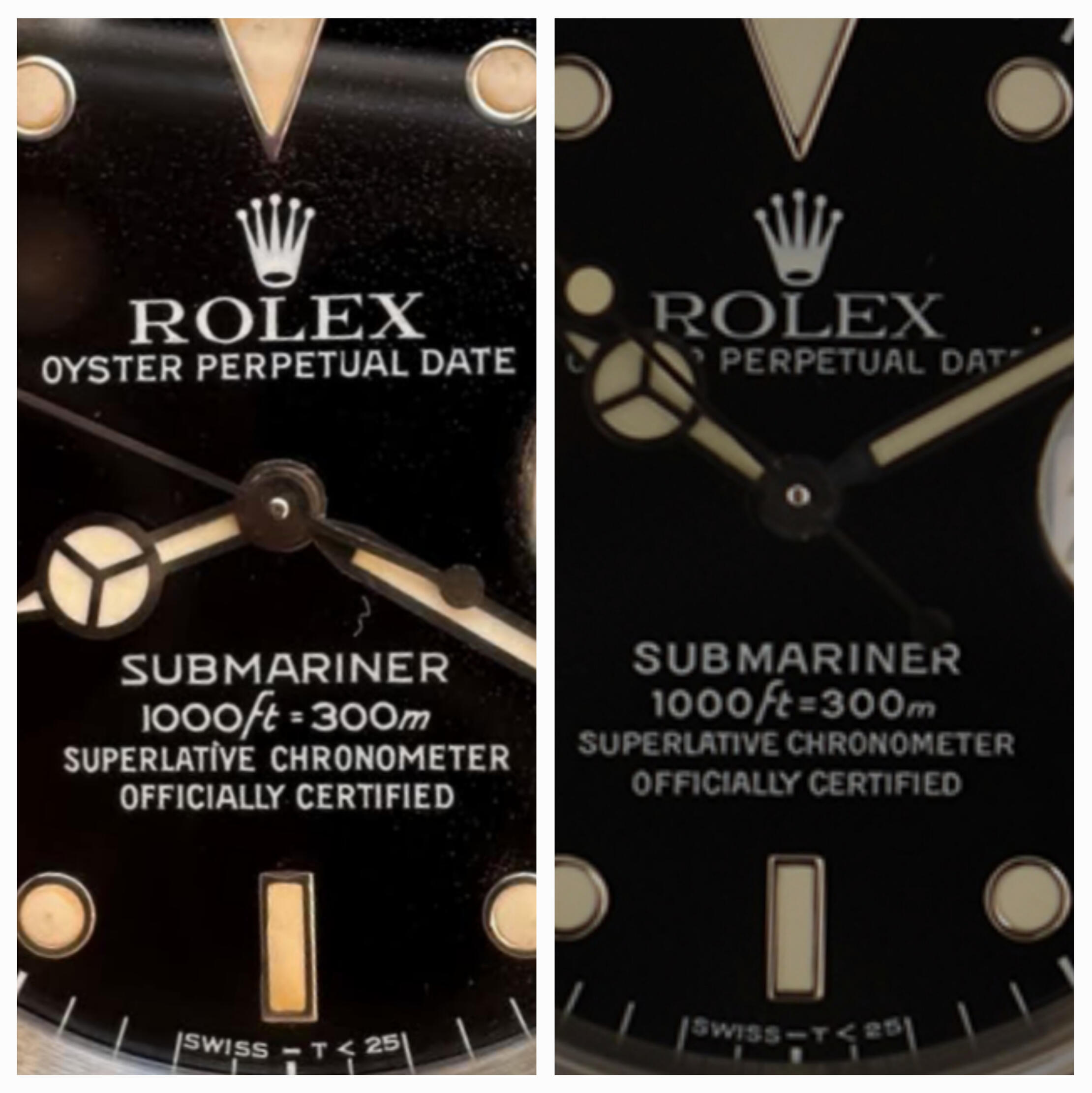
Origins of the Zubmariner Dial
Several historical factors may explain the emergence of this unusual dial variant.
The late 1980s marked a major transition period at Rolex, which likely led to some inconsistencies in dial supply and production :
Reference shifts and new materials : The Submariner ref. 168000 (produced circa 1987–1988) was a short-lived transitional model: mechanically identical to the 16800, but introducing 904L steel, a more corrosion-resistant alloy. It was quickly replaced by the ref. 16610 around 1988–1989, which introduced the new Caliber 3135. In this shifting landscape, Rolex may have used multiple dial suppliers or run production tests — which could explain the appearance of unusual typographic variations. One author even notes that “there is no official Rolex documentation referencing the 168000,” suggesting it may have been a proto-16800 in 904L steel. This adds weight to the theory that the period was somewhat experimental — the perfect breeding ground for a minor printing anomaly to slip through.
Evolution in dial printing techniques : During the ’80s, Rolex gradually moved away from matte painted dials (used throughout the ’70s and early ’80s) and toward glossy lacquered dials with applied white gold surrounds. Early glossy dials (1984–1989) were known to develop spider-like cracking over time due to lacquer instability. It's possible that the printing process itself — especially the dial pads or letter stencils — was still being fine-tuned. A minor flaw in the printing plate for the word “Submariner” (like a poorly defined S curve) could easily have produced the flattened S seen on Zubmariner dials. This theory fits the evidence: the variation disappeared after only a few years, suggesting Rolex quietly corrected the stencil or printing method behind the scenes.
Multiple dial suppliers : Rolex outsourced its dials to specialized manufacturers like Singer, Beyeler, and others. Each batch could feature small differences in typography or lacquer finish. It’s plausible that one supplier — intentionally or not — used a slightly modified typeface with flatter curves, resulting in the Zubmariner S. With no official documentation, experts can only speculate — but this “rogue supplier” theory comes up often in vintage watch discussions.
Lume transitions and the early 2000s anomaly : While most Zubmariner dials are from the late ’80s, a small resurgence of the flattened S occurred around 2002–2004. By the late ’90s, Rolex had transitioned from tritium lume to Luminova. In 1998, some of the last T<25 dials were re-lumed with Luminova but kept the same markings. In 1999, Rolex introduced dials marked “SWISS” (Luminova). In 2000, the “SWISS MADE” line signaled the arrival of SuperLuminova. These lume transitions may have coincided with minor font changes. The semi-Zorro dials observed on 14060M and 16610T models between 2002 and 2004 could stem from : leftover dial stock from transitional batches, or subtle updates in the pad-printing process, possibly linked to the introduction of SEL bracelets and no-hole cases. In short, it was a time of small production adjustments — and one such change might have briefly revived the flattened S.
In the absence of any official communication from Rolex, all of these theories remain speculative. What matters most is that the Zubmariner dial most likely resulted from a minor technical glitch — whether a printing font issue or a defective stencil — that was quickly corrected.It was neither intentional nor reproducible at scale, which explains its rarity.Ironically, what may have once been seen as a flaw by Rolex is now viewed as a desirable feature by today’s collectors.
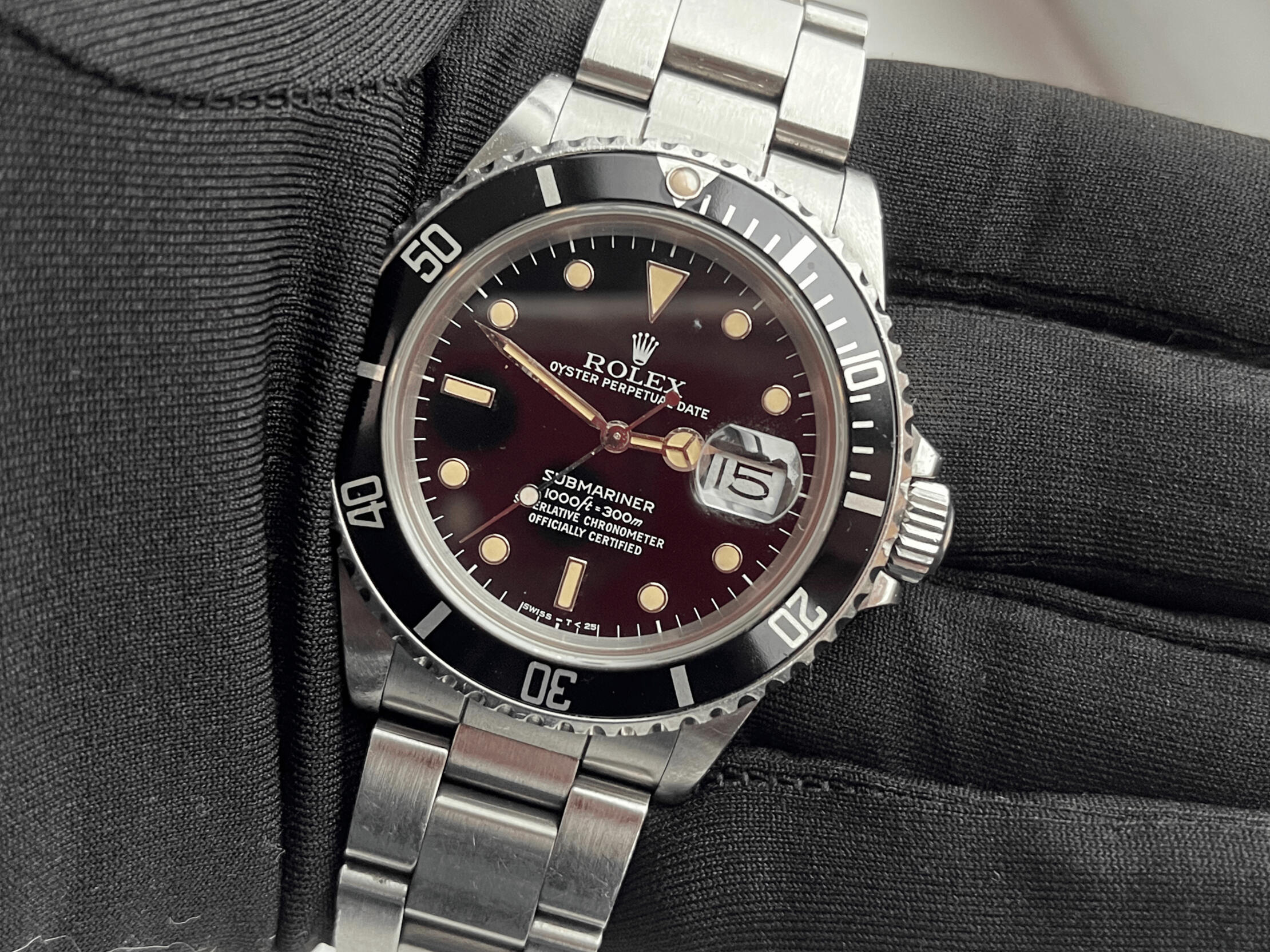
Collector and community reactions
The discovery and identification of Zubmariner/Zorro dials came directly from passionate watch forums and collector communities.As early as the 2000s and 2010s, users on forums like The Rolex Forum (TRF), Vintage Rolex Forum (VRF), and RolexForums began sharing photos of Submariners with “weird-looking S’s” and comparing notes.At first, the buzz remained niche — but over time, as the dial was better documented, the fascination grew. Today, platforms like Reddit host entire threads dedicated to the topic, where collectors proudly show off their finds. For instance, one user posts a Submariner 168000 with a Zorro dial, and another responds:“Hell yeah, looks like a nice 168000 Zorro dial. I have a 16610 ‘semi-Zorro,’ a rare variant that looks kinda Z-like.”These kinds of exchanges reflect the enthusiasm of seasoned collectors, who not only compare references, but also invent their own sub-labels like “semi-Zorro” to capture subtle variations.On French-language forums such as Chronomania and Forumamontres, similar discussions have emerged. The nickname “cadran Zorro” has gained traction as shorthand for a Submariner dial “where the S looks like a reversed Z.” Posts regularly point out that only late ’80s Subs carry this detail, and that it’s nonexistent on later series. When one member listed a 16610 with a Zubmariner dial for sale, others confirmed its rarity and authenticity — reinforcing that it wasn’t a swap or aftermarket dial, but a genuine Rolex production anomaly. In general, the French-speaking watch community has shown the same curiosity and passion as international collectors:
this is the kind of “deep cut” dial detail that sparks debates, comparisons, and detective work.Several experienced collectors and technical forum moderators have stepped in to verify the existence and legitimacy of these dials. On Replica-Watch.info, a technically oriented enthusiast forum, a member once asked whether a “Zorro” dial was authentic. Forum mod tripdog reviewed the photos and simply confirmed: “Yes, it’s genuine.”Another user added that this was a true Zub dial from the 1980s — likely on a 16800, 168000 or early 16610 — and explained that Rolex “hadn’t fully mastered its gloss lacquer process at the time,” leading to surface aging or cracking on some examples.This kind of expert validation reassures the community: the Zubmariner dial is not a myth or fabrication — it’s a real, Rolex-origin variant that simply flew under the radar for decades.
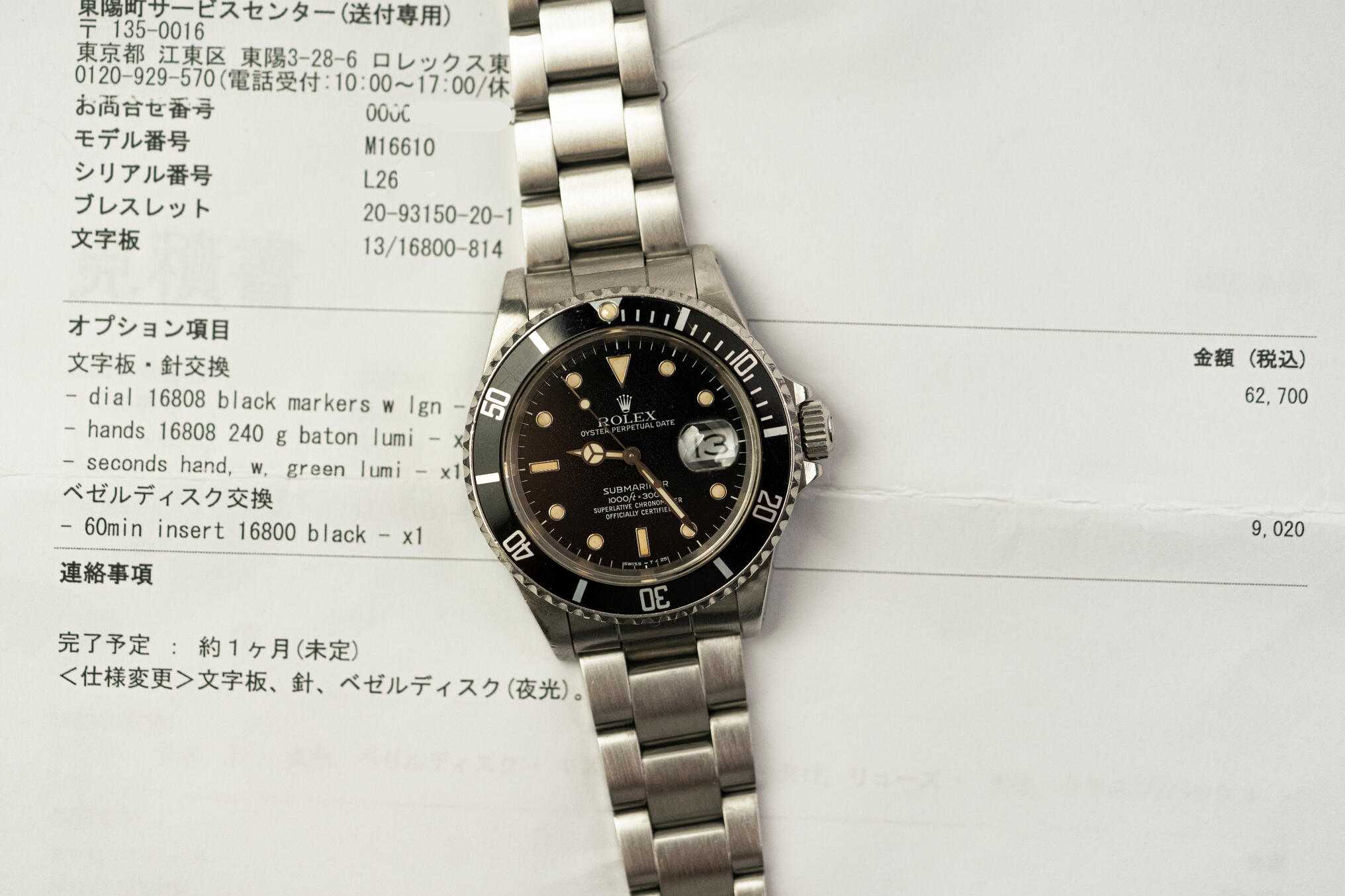
The Zubmariner dial is also beginning to appear in what one might call semi-official collector literature.In 2018, a respected collector known as Baron – Mr Red on WatchProSite published a series of essays on future Rolex classics. In his write-up on the Submariner 168000, he explicitly mentions the flat-S anomaly:“For some reason (and this also applies across a few other Submariners) the top and bottom of the S can be flat, making it more like a Zubmariner. (…) The ‘Z’ appears in about 1 in 10 of the ones that I have seen. Finding one with a Zubmariner dial… well, good luck!”He underscores its extreme rarity, calling it one of the features that “ticks all the boxes” to make the 168000 a future classic for collectors.On the same forum, another user referred to the Zubmariner as a “unicorn” — nearly impossible to find in fully original configuration. A lively debate followed about how many months of production the dial spanned and which serial ranges are affected — clear signs that the Zubmariner has become a point of fascination for serious collectors.Some even call the variant “controversial,” likely because it challenges the idea of total uniformity in Rolex production. Its very existence was doubted at one time — some believed it was a trick of the eye or the result of dial retouching.In short, the watch collecting community — from forums to social media — has played a key role in identifying, validating, and promoting the Zubmariner dial.
What began as a niche curiosity has become a legitimate subject of Rolex scholarship, on par with other quirky or “error” dials like: the Underline, the Bart Simpson, or the “Swiss Only” print variations.Reactions range from amused fascination with this typographic oddity to genuine excitement from collectors who now recognize it as a rare historical feature — a mistake turned collectible.
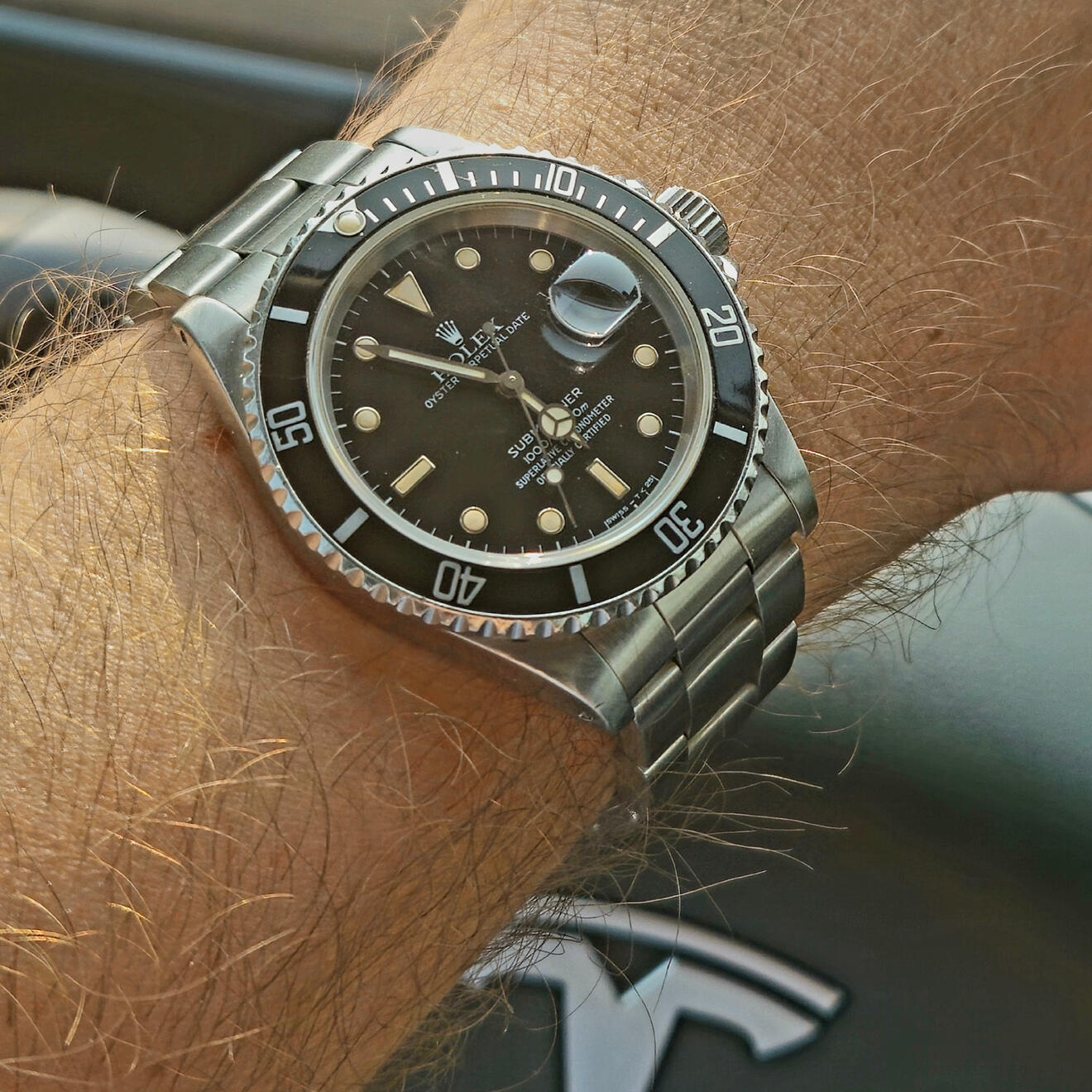
Testimonials from Buyers, Experts, and Dealers
Several first-hand accounts illustrate the growing interest in the Zubmariner dial.
One watchmaker-collector who assembles “Frankenwatches” shared how he stumbled upon an original dial for sale. He immediately noticed it was something he had never seen replicated, remarking that to his knowledge, no replica version of this dial existed. Only later did he realize he had found the now-famous Zubmariner dial, which he quickly purchased for a custom build.The mere fact that no counterfeit versions were circulating at the time speaks volumes — even counterfeiters didn’t know it existed, proving how obscure and insider-only this variant was. Today, as the concept gains traction, it's not impossible that copies might emerge, but owning a genuine Zubmariner dial still strongly indicates Rolex authenticity.
Dealers take notice — and educateProfessional dealers have also begun highlighting the Zubmariner as a valuable quirk. One UK-based seller listed a 1990 Submariner 16610, pointing out that it featured a “Mk II dial, easily recognized by the S in Submariner resembling a reversed Z.” He wisely added:“As we all know, it’s the small, subtle differences that make a watch truly collectible.” He compared it to other legendary dial anomalies like the Daytona “APH dial” (where COSMOGR APH appears split).Another seller, Tempvs Watches, offered a 2002 Submariner 16610 with the flattened “S” printing quirk, explaining:
“Collectors know just how much small print differences can drive big price changes — ask anyone with a ‘Fat Four,’ ‘Inverted 6,’ or an ‘APH dial.’”These examples show how dealers are now educating their clients, bringing this once-hidden quirk out of the realm of hardcore collectors and into the mainstream vintage Rolex conversation.In the French market, the same trend is taking hold. A private seller specifically mentioned in their listing: “The S is different from other Submariner 16610s.” and emphasized that this was a rare, original dial.Again, such transparency is designed to attract informed collectors and justify a premium, especially among those already attuned to subtle dial variants. Many Zubmariner owners are passionate collectors themselves, eager to share what they know and turn their watch’s story into a selling point and source of horological pride.Renowned horological experts and collectors — including Eric Ku, John Mayer, and Mondani — have spoken in interviews and discussions about the rising value of “quirky” vintage Rolex dials. The Zubmariner fits squarely into this trend: what was once a printing mistake is now viewed as a desirable collector’s trait.In that sense, the Zorro dial has matured from misunderstood flaw to recognized feature — officially unofficial, and increasingly in demand.
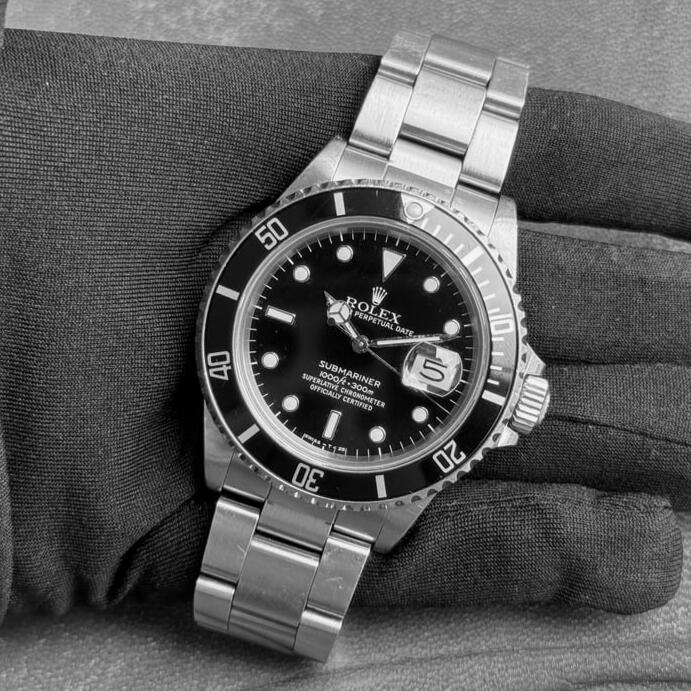
Rarity and Estimated Numbers in Circulation
It’s extremely difficult to determine exactly how many Submariners were originally fitted with a Zubmariner dial, but all available clues point to one clear conclusion: they are incredibly rare.🔹 1988–1990: The earliest sightingsRolex did not publish production volumes by reference, but it’s widely accepted that the ref. 168000 was only produced for a few months.
Estimates suggest roughly 17,000 pieces were made in total. If only ~10% featured the flattened “S”, based on collector observations, that would amount to just a few hundred watches — perhaps 1,000–2,000 at most.As for early 16610 models (1988–1990), the proportion is harder to gauge. It’s likely that only the earliest batches — R-series (late 1988), L-series (1989), and maybe early E-series (1990) — carried the Mk II dial with the signature flat S, before Rolex corrected the printing with a Mk III.If we extrapolate, the total number might include a few thousand watches at best. But many of these have likely vanished or been altered.
Throughout the 1990s and early 2000s, it was common for vintage Submariners to go through Rolex Service, where tritium dials were often swapped for newer Luminova “service dials.”At the time, there was little awareness that this S anomaly mattered — and Rolex had a policy of automatically replacing aged lume parts.
One expert notes that finding a 168000 with its original tritium dial is already rare, since Rolex was known to routinely remove original components during servicing. Each dial lost in service is one less Zubmariner in the world today.🔹 2000s: The “Semi-Zorro” dialsEven the more recent “semi-Z” examples are scarce. Around 5% of 14060M no-date Submariners from the early 2000s are thought to carry a flattened or squared-off S. A similar percentage likely applies to 16610s from 2002–2004, though production volumes were modest (no-date Subs sold less than Sub Dates). Even these partial Zs remain hard to find today.🔹 A real unicorn huntAmong collectors, the Zubmariner is treated like a unicorn. Forum members actively track auction listings, Chrono24 appearances, and private sales, hoping to estimate how many might still exist.A cautious estimate would be: a few hundred Zubmariner-equipped Submariners worldwide, across all references. And of those, many are likely sitting in private vaults rather than circulating on the open market.One strong indicator of this rarity: every public sighting sparks immediate interest. When a Zubmariner is listed for sale on a forum, the news spreads quickly across Reddit, Instagram, and collector groups.One recent Instagram post wondered aloud: “I wonder how many of the 17,338 produced got Z signed.”That curiosity — and the lack of a clear answer — has only added to the mystique. In short: we don’t know exactly how many exist, but we know it’s very, very few.
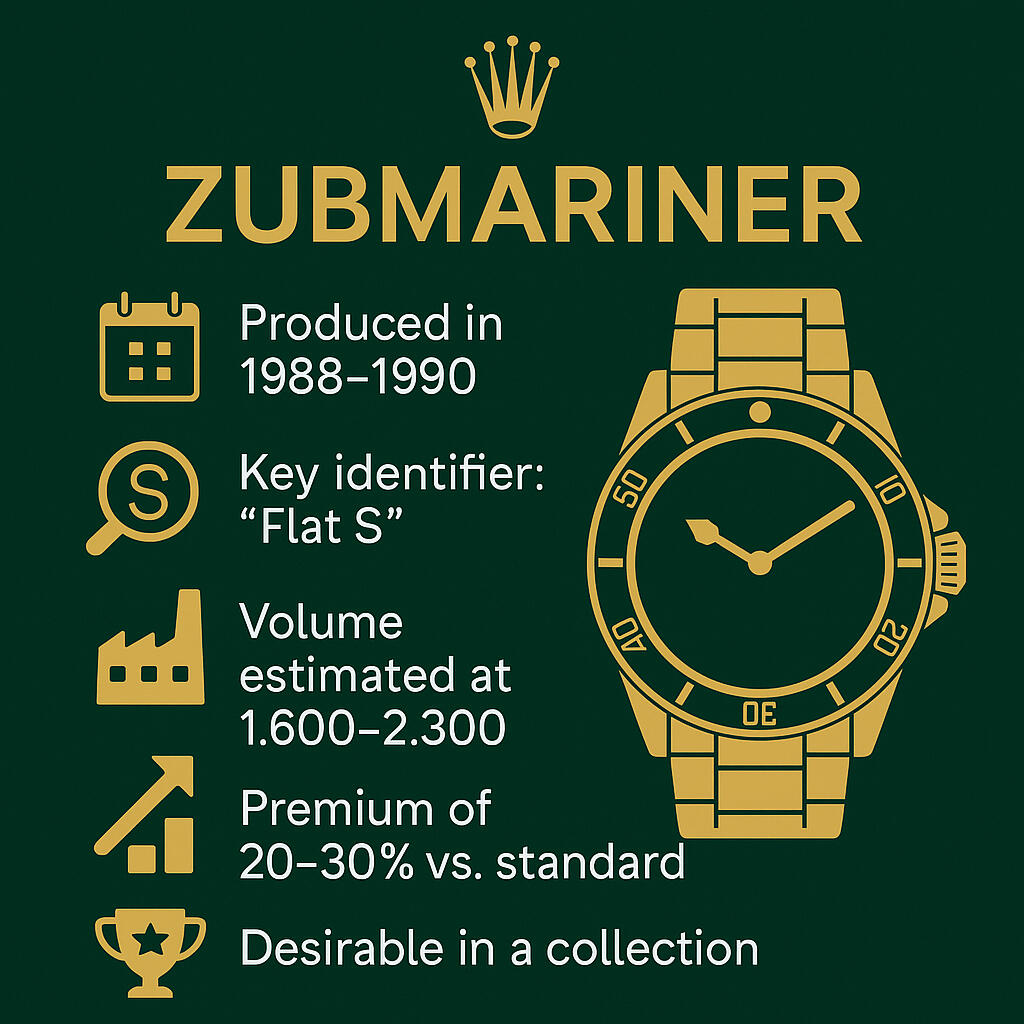
Price evolution and market value
The value of Submariners featuring the Zubmariner dial has seen a steady rise in recent years, as the collector community becomes increasingly aware of its rarity.For a long time, these watches traded for the same price as any other vintage Submariner — the flat “S” detail going unnoticed by most buyers and sellers.
But today, this quirk is highlighted in listings and commands a notable premium among enthusiasts.🔹 Early 2010s: Under the radarIn the early 2010s, few listings explicitly referenced the Zubmariner.
It's likely that some examples changed hands without either party realizing they were dealing with a rare dial variant.🔹 Late 2010s: Emerging awareness
By the late 2010s, the first references to Zubmariner dials started appearing in listings and forum discussions. In 2018, for instance, a forum user asked for help valuing a Submariner 168000 with a Z dial, suggesting that a market premium was starting to form. That same year, well-respected collector Baron (Mr. Red) published an article calling it a future classic, which helped spotlight the variant — and attracted both collectors and speculators.🔹 Early 2020s: Premium justified
By 2021, the premium had become more visible. A Submariner 16610 Zubmariner (no papers) was listed on the French market for €8,500 — while a standard tritium 16610 from the same period typically sold for €6–7k. The listing emphasized the rare dial, and the watch sold quickly — proof that some collectors are willing to pay for the detail. In 2022, a Facebook listing by dealer Mondani offered a 1988 full set Zubmariner 16610 for €10,890 — showing a significant jump in value, even when accounting for the improved condition and provenance.🔹 International market: similar trend
Internationally, the trend is similar. Online auctions and Reddit listings have featured 168000 “ghost” Zubmariners ranging from $9,000 to $12,000 USD for unpolished examples. On Chrono24, Zubmariner-labeled 168000 and 16610 models typically ask 15–20% more than their standard counterparts. For example, one Canadian seller priced a 1988 Sub Date 168000 with a Z dial at around $13,500 CAD.🔹 Auction houses: not yet mainstream, but soon?
So far, major auction houses (like Christie’s or Phillips) have yet to feature a Zubmariner under that name — but it's only a matter of time. The day a “Zubmariner Dial” gets officially labeled in a catalogue, bidding could reflect its rarity more visibly. For now, most examples trade privately or via niche platforms, among knowledgeable collectors.🔹 Condition matters
Of course, value depends on overall condition and authenticity. A Zubmariner dial only matters if it’s original, paired with its matching tritium hands, and mounted on the correct reference. A full set example — box, papers, original purchase receipt — commands an even bigger premium. One seller described a 1990 full set 16610 Zubmariner as “a perfect collector’s set, yet still robust enough to wear daily” — marketing it as both an investment and a wearable piece.🔹 Still room to grow?Overall, prices are climbing, following a pattern familiar in the Rolex world: forum discovery → dealer narrative → collector demand.
Just a few years ago, a late-’80s tritium Submariner might have sold for €5–6k. Today, the same watch with a Zubmariner dial can fetch double that, in good condition.
Some collectors believe the variant remains undervalued compared to other Rolex dial oddities (like Comex, “Swiss Only”, or APH dials), suggesting further upside. As Baron wrote in his now-famous article: “It ticks a lot of the boxes for a future classic.”In other words: buying one now might prove a smart move.🔹 Niche market, but serious valueThat said, caution is warranted: Zubmariner-mania is still a niche affair.
Liquidity is low, and only serious collectors recognize its value.
But for them, owning a 16610 or 168000 with this dial is like holding a piece of Rolex history — an accidental wink from the Crown that fuels stories, discussions, and passion.And that, as the saying goes, is priceless.
(Or rather, increasingly expensive — depending on who’s asking.)
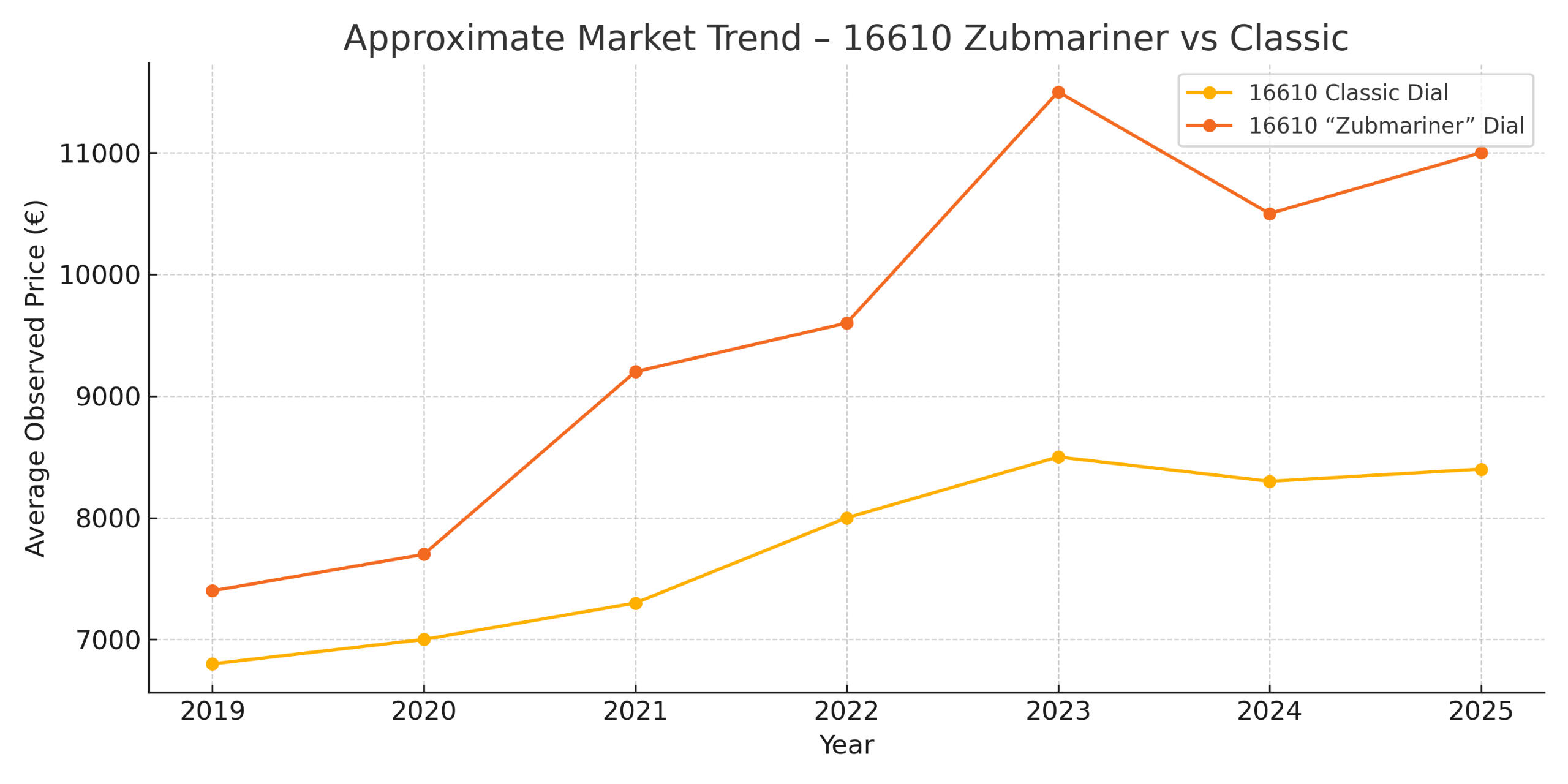
Sources & References :
Submariner 16610 “Zubmariner” – Listing on Chronomania (2021)
Reddit thread: “Cool Rolex of the Day – Zorro Dial”
RWG Forum – Flat S dial typographic analysis
Baron (Mr Red), WatchProSite article series on future classic Rolex models (2018)
Community comments – WatchProSite (2018–2019)
watchprosite.com
RWI Forum discussion thread (2020)
Dealer listings: TheWatchCollector, Tempvs Watches
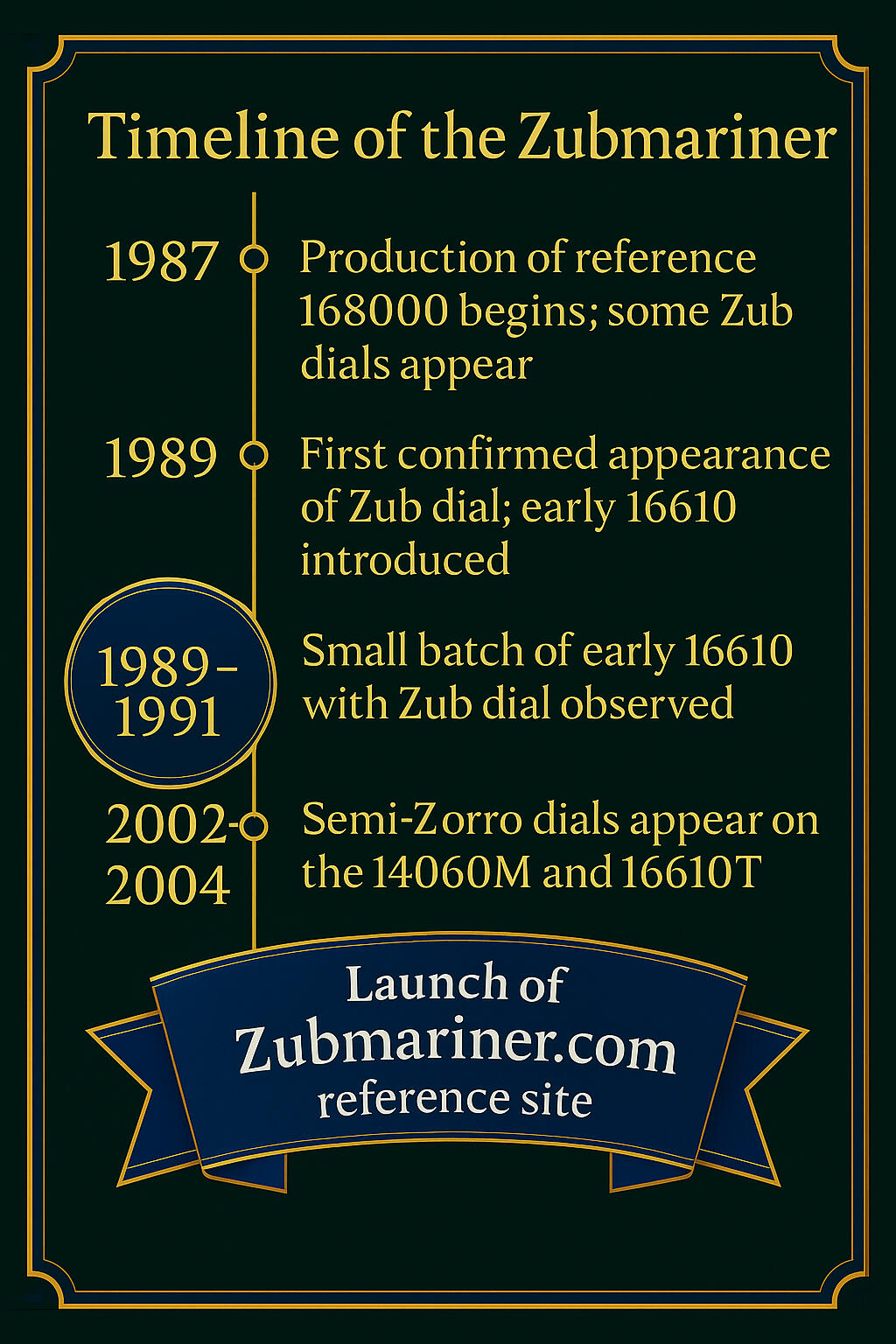
This site was created in 2025 by a Rolex enthusiast wishing to share the results of his extensive research. It has no connection with the Rolex brand and does not offer investment advice.
